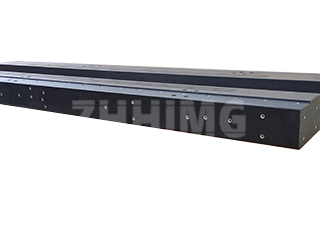The need for dimensional stability in high-precision measurement is absolute. While granite is universally lauded for its thermal stability and vibration damping, a common question arises from engineers in humid climates: How does moisture affect a precision granite platform?
It’s a valid concern, as any material used as a reference plane for micrometers or CMMs must resist environmental influence. The short answer is: due to the carefully selected material and processing, high-quality precision granite is highly resistant to moisture effects.
The Role of Low Water Absorption in Metrology
Granite, as a natural stone, does possess some level of porosity. However, the specific types of black granite used by ZHHIMG for metrology applications are chosen precisely for their dense, fine-grained structure, which inherently leads to a minimal water absorption rate.
Standard metrology-grade granite typically features a water absorption rate below 0.13% (many premium varieties are even lower, often closer to 0.07% or less). This characteristic is crucial for maintaining accuracy over the long term:
- Minimizing Hygroscopic Expansion: While some materials can swell or contract significantly as they absorb or release moisture (hygroscopic expansion), the extremely low porosity of precision granite drastically limits this effect. The amount of water absorbed by the stone is negligible, preventing any significant dimensional change that could affect the reference plane’s flatness.
- Protection Against Rust: Perhaps a more practical advantage is the protection it offers your valuable tools. If a surface plate had high porosity, it would retain moisture near the surface. This moisture can cause corrosion and rust on the metal gauges, accessories, and components placed on the granite, leading to premature wear and contaminated measurements. The low porosity of our Black Granite Components minimizes this risk, supporting a rust-free environment.
Humidity vs. Accuracy: Understanding the Real Threat
While granite itself resists dimensional deformation from atmospheric humidity, we must clarify the distinction between the material’s stability and environmental control in a precision lab:
| Factor | Direct Effect on Granite Platform |
Indirect Effect on Measurement System
|
| Water Absorption Rate | Negligible dimensional change (low porosity) |
Minimized risk of rust on accessories and gauges.
|
| Ambient Humidity (High) | Negligible deformation of the granite slab itself. |
Significant: Increased risk of condensation on metal measuring instruments, potentially affecting CMM calibration and optical readings.
|
| Ambient Humidity (Low) | Negligible change to the granite slab. |
Increased static electricity, attracting micro-particles that cause wear and flatness issues.
|
As experts in Ultra-Precision Platforms, we recommend that clients maintain a humidity-controlled environment, ideally between 50% and 60% Relative Humidity (RH). This control is less about protecting the granite slab and more about safeguarding the entire metrology system (CMMs, gauges, optics) and ensuring the thermal stability of the air itself.
ZHHIMG’s Guarantee of Enduring Stability
The granite we select—renowned for its superior density and fine grain—offers an inherently stable foundation against both thermal and moisture fluctuations. Our commitment to using granite with high specific gravity ensures that you receive a durable, corrosion-resistant inspection table that will maintain its original flatness and integrity for decades, requiring only standard professional recalibration due to wear, not environmental deformation.
When you invest in a ZHHIMG Precision Granite base, you are investing in a foundation engineered for the rigors of any high-tolerance measurement environment.
Post time: Oct-14-2025

